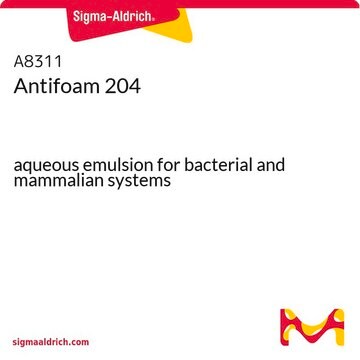A6457
Antifoam Y-30 Emulsion
aqueous emulsion for bacterial and mammalian systems
About This Item
Recommended Products
description
Molecular Biology Reagent
form
emulsion (aqueous)
concentration
30% (active silicon)
technique(s)
cell culture | hybridoma: suitable
density
1.0 g/mL at 25 °C
application(s)
microbiology
storage temp.
room temp
suitability
(Mammalian (suspension))
bacteria (fermentation)
General description
Application
Components
Preparation Note
Storage Class
10 - Combustible liquids
wgk_germany
WGK 3
flash_point_f
Not applicable
flash_point_c
Not applicable
ppe
Eyeshields, Gloves, type ABEK (EN14387) respirator filter
Choose from one of the most recent versions:
Already Own This Product?
Find documentation for the products that you have recently purchased in the Document Library.
Customers Also Viewed
Our team of scientists has experience in all areas of research including Life Science, Material Science, Chemical Synthesis, Chromatography, Analytical and many others.
Contact Technical Service












